Report on Online Entrepreneurship Interview: Innovation Insights
VerifiedAdded on 2020/03/16
|19
|5738
|28
Report
AI Summary
This report presents an analysis of an in-person interview conducted with an online entrepreneur, Peter, exploring various aspects of online entrepreneurship. The interview delves into Peter's online marketing strategies, the evolution of his business, and his goals, including reaching a larger market and ensuring customer satisfaction. It highlights the challenges he faces, such as website management and negative online content, and his approaches to address them. The report further examines Peter's marketing methods, his reasons for choosing online marketing, and the advice he offers to aspiring entrepreneurs. Additionally, the report includes a self-reflection on the student's own capabilities related to innovation management, such as flexibility, innovation, risk-taking, motivation, versatility, decisiveness, and technological proficiency. It also outlines a plan for skill development using the SMART framework, focusing on technological capability and other essential skills for success in innovation management.
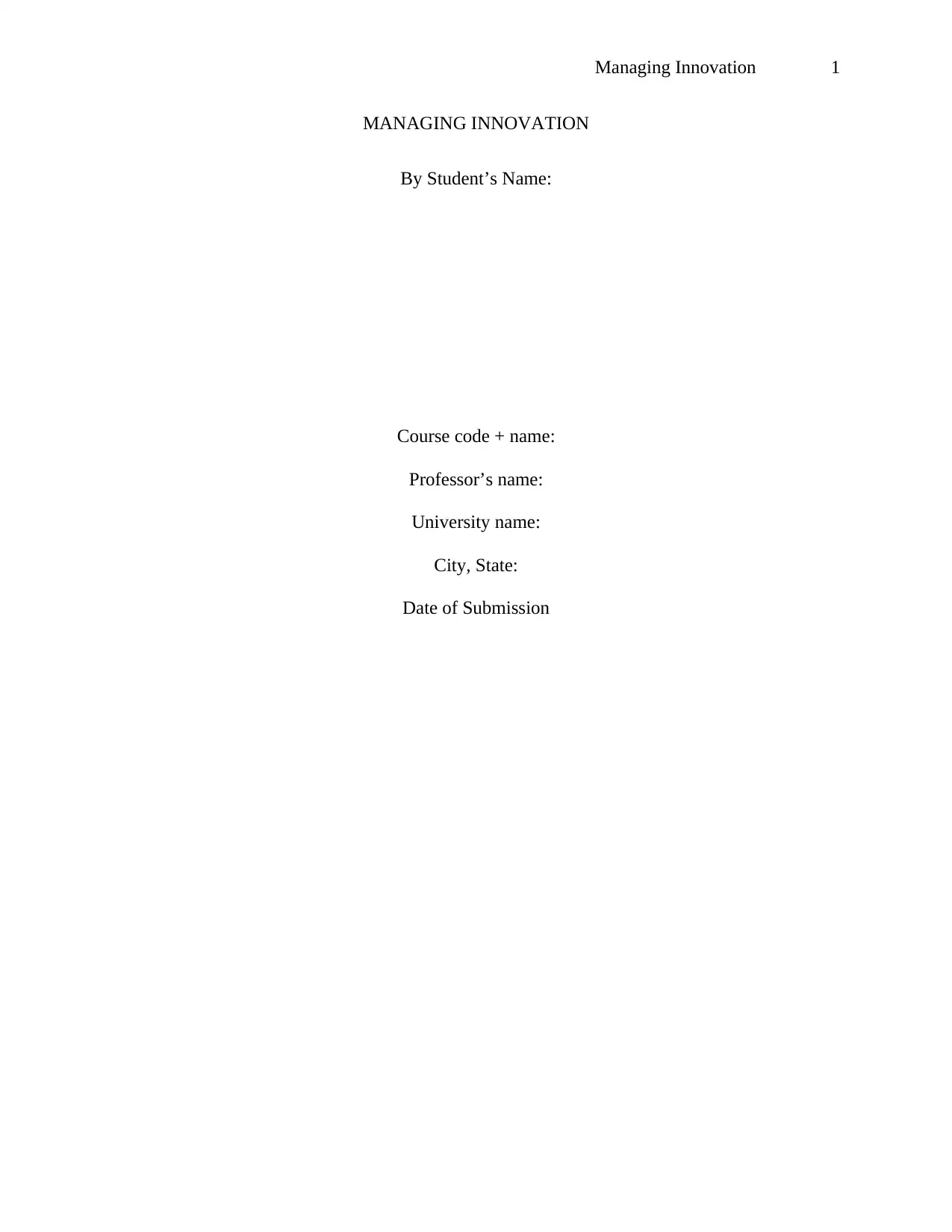
Managing Innovation 1
MANAGING INNOVATION
By Student’s Name:
Course code + name:
Professor’s name:
University name:
City, State:
Date of Submission
MANAGING INNOVATION
By Student’s Name:
Course code + name:
Professor’s name:
University name:
City, State:
Date of Submission
Paraphrase This Document
Need a fresh take? Get an instant paraphrase of this document with our AI Paraphraser
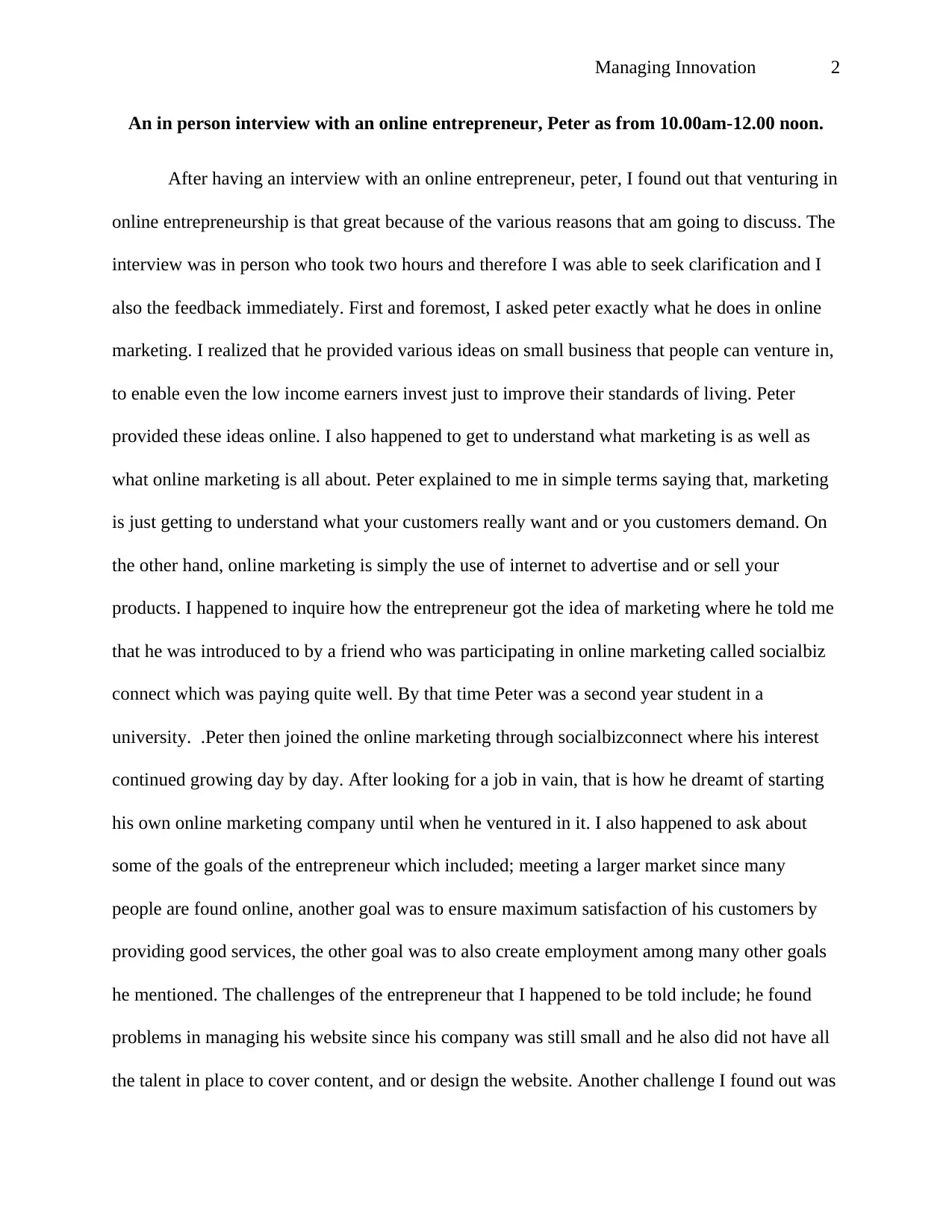
Managing Innovation 2
An in person interview with an online entrepreneur, Peter as from 10.00am-12.00 noon.
After having an interview with an online entrepreneur, peter, I found out that venturing in
online entrepreneurship is that great because of the various reasons that am going to discuss. The
interview was in person who took two hours and therefore I was able to seek clarification and I
also the feedback immediately. First and foremost, I asked peter exactly what he does in online
marketing. I realized that he provided various ideas on small business that people can venture in,
to enable even the low income earners invest just to improve their standards of living. Peter
provided these ideas online. I also happened to get to understand what marketing is as well as
what online marketing is all about. Peter explained to me in simple terms saying that, marketing
is just getting to understand what your customers really want and or you customers demand. On
the other hand, online marketing is simply the use of internet to advertise and or sell your
products. I happened to inquire how the entrepreneur got the idea of marketing where he told me
that he was introduced to by a friend who was participating in online marketing called socialbiz
connect which was paying quite well. By that time Peter was a second year student in a
university. .Peter then joined the online marketing through socialbizconnect where his interest
continued growing day by day. After looking for a job in vain, that is how he dreamt of starting
his own online marketing company until when he ventured in it. I also happened to ask about
some of the goals of the entrepreneur which included; meeting a larger market since many
people are found online, another goal was to ensure maximum satisfaction of his customers by
providing good services, the other goal was to also create employment among many other goals
he mentioned. The challenges of the entrepreneur that I happened to be told include; he found
problems in managing his website since his company was still small and he also did not have all
the talent in place to cover content, and or design the website. Another challenge I found out was
An in person interview with an online entrepreneur, Peter as from 10.00am-12.00 noon.
After having an interview with an online entrepreneur, peter, I found out that venturing in
online entrepreneurship is that great because of the various reasons that am going to discuss. The
interview was in person who took two hours and therefore I was able to seek clarification and I
also the feedback immediately. First and foremost, I asked peter exactly what he does in online
marketing. I realized that he provided various ideas on small business that people can venture in,
to enable even the low income earners invest just to improve their standards of living. Peter
provided these ideas online. I also happened to get to understand what marketing is as well as
what online marketing is all about. Peter explained to me in simple terms saying that, marketing
is just getting to understand what your customers really want and or you customers demand. On
the other hand, online marketing is simply the use of internet to advertise and or sell your
products. I happened to inquire how the entrepreneur got the idea of marketing where he told me
that he was introduced to by a friend who was participating in online marketing called socialbiz
connect which was paying quite well. By that time Peter was a second year student in a
university. .Peter then joined the online marketing through socialbizconnect where his interest
continued growing day by day. After looking for a job in vain, that is how he dreamt of starting
his own online marketing company until when he ventured in it. I also happened to ask about
some of the goals of the entrepreneur which included; meeting a larger market since many
people are found online, another goal was to ensure maximum satisfaction of his customers by
providing good services, the other goal was to also create employment among many other goals
he mentioned. The challenges of the entrepreneur that I happened to be told include; he found
problems in managing his website since his company was still small and he also did not have all
the talent in place to cover content, and or design the website. Another challenge I found out was
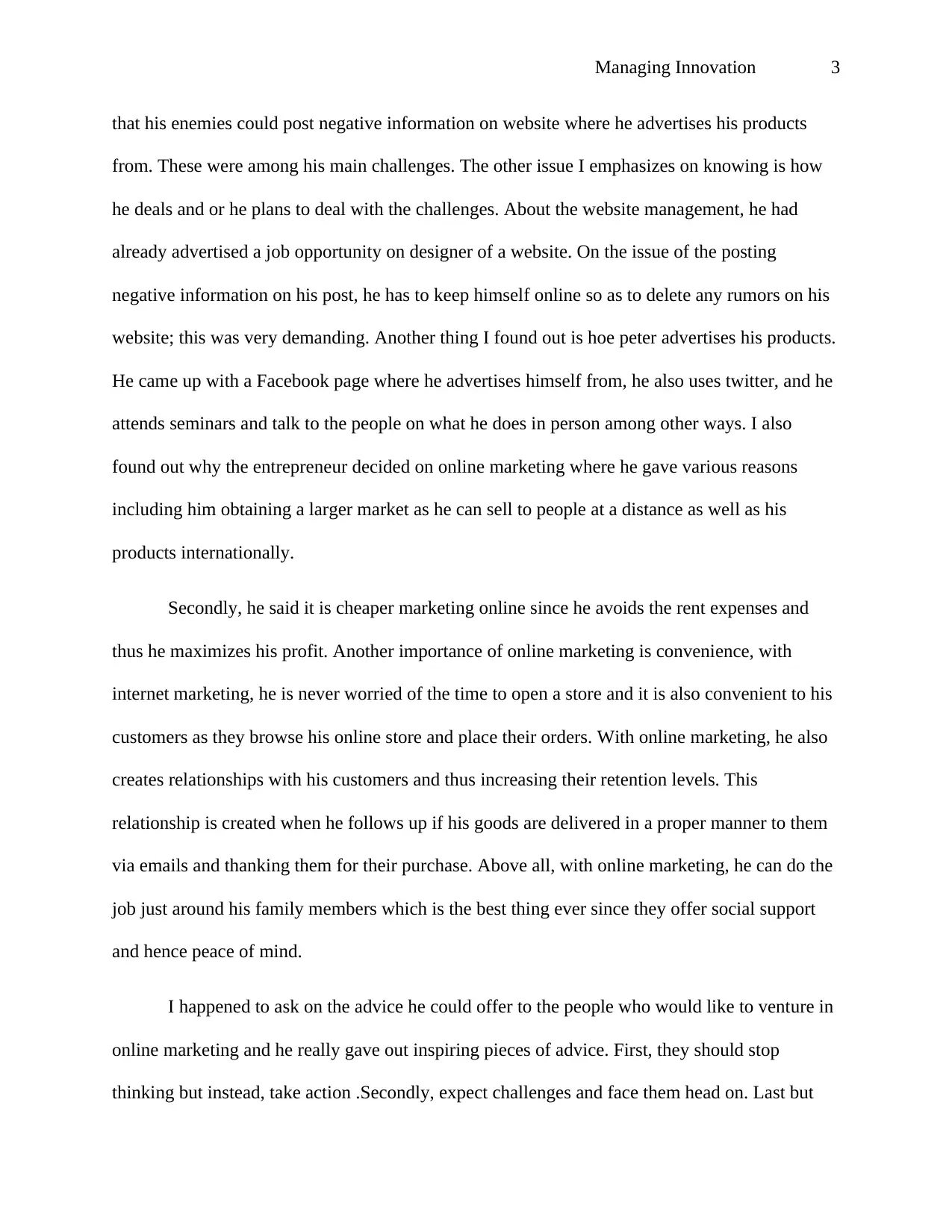
Managing Innovation 3
that his enemies could post negative information on website where he advertises his products
from. These were among his main challenges. The other issue I emphasizes on knowing is how
he deals and or he plans to deal with the challenges. About the website management, he had
already advertised a job opportunity on designer of a website. On the issue of the posting
negative information on his post, he has to keep himself online so as to delete any rumors on his
website; this was very demanding. Another thing I found out is hoe peter advertises his products.
He came up with a Facebook page where he advertises himself from, he also uses twitter, and he
attends seminars and talk to the people on what he does in person among other ways. I also
found out why the entrepreneur decided on online marketing where he gave various reasons
including him obtaining a larger market as he can sell to people at a distance as well as his
products internationally.
Secondly, he said it is cheaper marketing online since he avoids the rent expenses and
thus he maximizes his profit. Another importance of online marketing is convenience, with
internet marketing, he is never worried of the time to open a store and it is also convenient to his
customers as they browse his online store and place their orders. With online marketing, he also
creates relationships with his customers and thus increasing their retention levels. This
relationship is created when he follows up if his goods are delivered in a proper manner to them
via emails and thanking them for their purchase. Above all, with online marketing, he can do the
job just around his family members which is the best thing ever since they offer social support
and hence peace of mind.
I happened to ask on the advice he could offer to the people who would like to venture in
online marketing and he really gave out inspiring pieces of advice. First, they should stop
thinking but instead, take action .Secondly, expect challenges and face them head on. Last but
that his enemies could post negative information on website where he advertises his products
from. These were among his main challenges. The other issue I emphasizes on knowing is how
he deals and or he plans to deal with the challenges. About the website management, he had
already advertised a job opportunity on designer of a website. On the issue of the posting
negative information on his post, he has to keep himself online so as to delete any rumors on his
website; this was very demanding. Another thing I found out is hoe peter advertises his products.
He came up with a Facebook page where he advertises himself from, he also uses twitter, and he
attends seminars and talk to the people on what he does in person among other ways. I also
found out why the entrepreneur decided on online marketing where he gave various reasons
including him obtaining a larger market as he can sell to people at a distance as well as his
products internationally.
Secondly, he said it is cheaper marketing online since he avoids the rent expenses and
thus he maximizes his profit. Another importance of online marketing is convenience, with
internet marketing, he is never worried of the time to open a store and it is also convenient to his
customers as they browse his online store and place their orders. With online marketing, he also
creates relationships with his customers and thus increasing their retention levels. This
relationship is created when he follows up if his goods are delivered in a proper manner to them
via emails and thanking them for their purchase. Above all, with online marketing, he can do the
job just around his family members which is the best thing ever since they offer social support
and hence peace of mind.
I happened to ask on the advice he could offer to the people who would like to venture in
online marketing and he really gave out inspiring pieces of advice. First, they should stop
thinking but instead, take action .Secondly, expect challenges and face them head on. Last but
⊘ This is a preview!⊘
Do you want full access?
Subscribe today to unlock all pages.

Trusted by 1+ million students worldwide
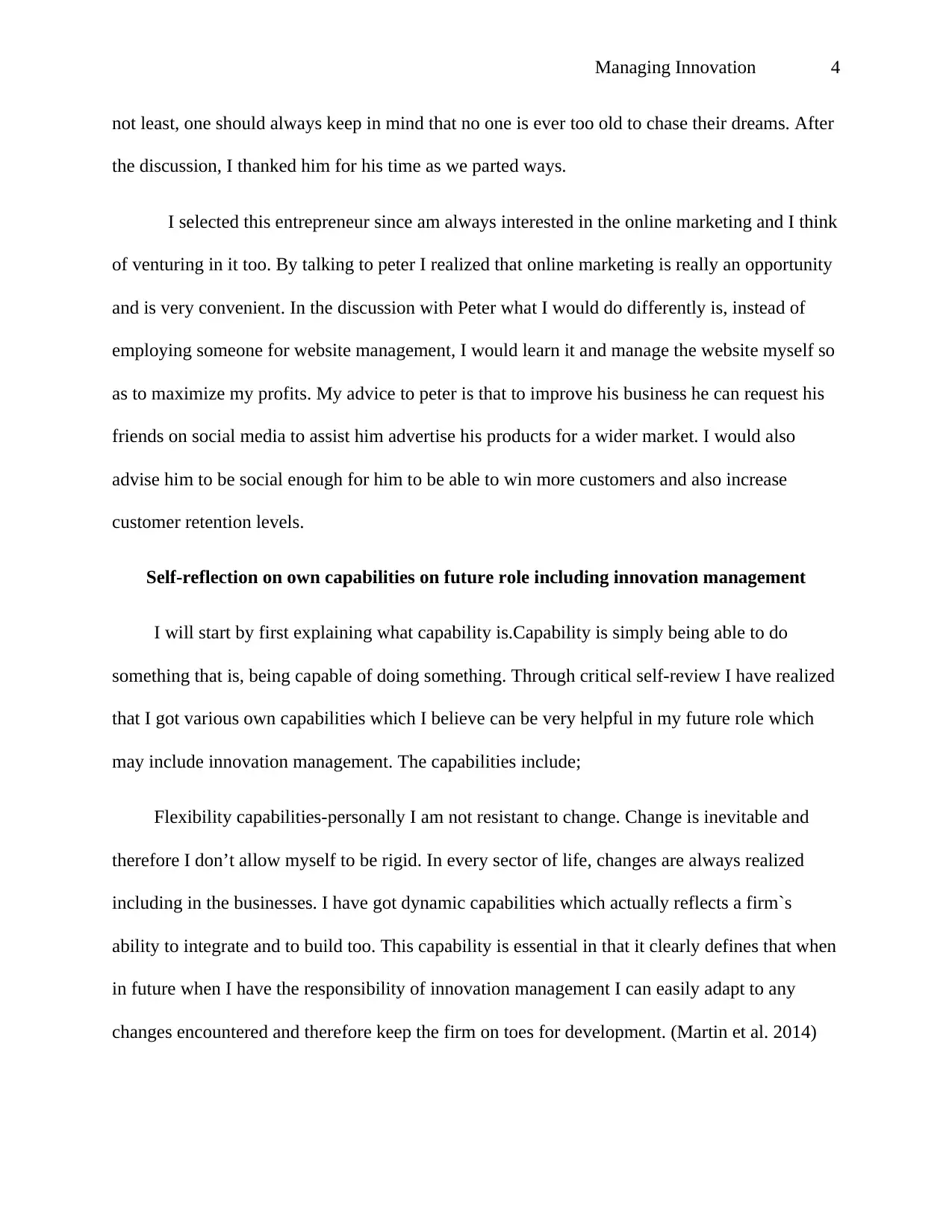
Managing Innovation 4
not least, one should always keep in mind that no one is ever too old to chase their dreams. After
the discussion, I thanked him for his time as we parted ways.
I selected this entrepreneur since am always interested in the online marketing and I think
of venturing in it too. By talking to peter I realized that online marketing is really an opportunity
and is very convenient. In the discussion with Peter what I would do differently is, instead of
employing someone for website management, I would learn it and manage the website myself so
as to maximize my profits. My advice to peter is that to improve his business he can request his
friends on social media to assist him advertise his products for a wider market. I would also
advise him to be social enough for him to be able to win more customers and also increase
customer retention levels.
Self-reflection on own capabilities on future role including innovation management
I will start by first explaining what capability is.Capability is simply being able to do
something that is, being capable of doing something. Through critical self-review I have realized
that I got various own capabilities which I believe can be very helpful in my future role which
may include innovation management. The capabilities include;
Flexibility capabilities-personally I am not resistant to change. Change is inevitable and
therefore I don’t allow myself to be rigid. In every sector of life, changes are always realized
including in the businesses. I have got dynamic capabilities which actually reflects a firm`s
ability to integrate and to build too. This capability is essential in that it clearly defines that when
in future when I have the responsibility of innovation management I can easily adapt to any
changes encountered and therefore keep the firm on toes for development. (Martin et al. 2014)
not least, one should always keep in mind that no one is ever too old to chase their dreams. After
the discussion, I thanked him for his time as we parted ways.
I selected this entrepreneur since am always interested in the online marketing and I think
of venturing in it too. By talking to peter I realized that online marketing is really an opportunity
and is very convenient. In the discussion with Peter what I would do differently is, instead of
employing someone for website management, I would learn it and manage the website myself so
as to maximize my profits. My advice to peter is that to improve his business he can request his
friends on social media to assist him advertise his products for a wider market. I would also
advise him to be social enough for him to be able to win more customers and also increase
customer retention levels.
Self-reflection on own capabilities on future role including innovation management
I will start by first explaining what capability is.Capability is simply being able to do
something that is, being capable of doing something. Through critical self-review I have realized
that I got various own capabilities which I believe can be very helpful in my future role which
may include innovation management. The capabilities include;
Flexibility capabilities-personally I am not resistant to change. Change is inevitable and
therefore I don’t allow myself to be rigid. In every sector of life, changes are always realized
including in the businesses. I have got dynamic capabilities which actually reflects a firm`s
ability to integrate and to build too. This capability is essential in that it clearly defines that when
in future when I have the responsibility of innovation management I can easily adapt to any
changes encountered and therefore keep the firm on toes for development. (Martin et al. 2014)
Paraphrase This Document
Need a fresh take? Get an instant paraphrase of this document with our AI Paraphraser
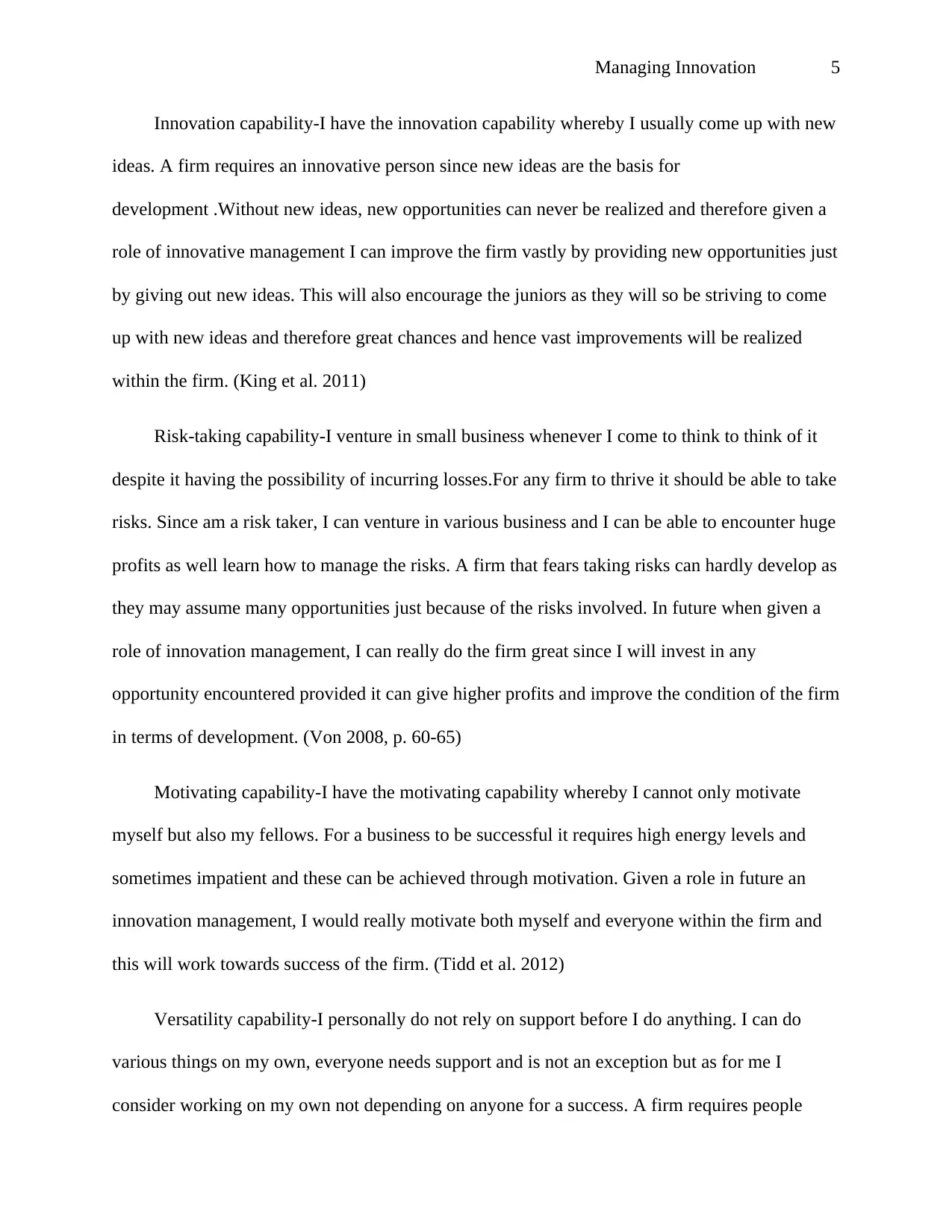
Managing Innovation 5
Innovation capability-I have the innovation capability whereby I usually come up with new
ideas. A firm requires an innovative person since new ideas are the basis for
development .Without new ideas, new opportunities can never be realized and therefore given a
role of innovative management I can improve the firm vastly by providing new opportunities just
by giving out new ideas. This will also encourage the juniors as they will so be striving to come
up with new ideas and therefore great chances and hence vast improvements will be realized
within the firm. (King et al. 2011)
Risk-taking capability-I venture in small business whenever I come to think to think of it
despite it having the possibility of incurring losses.For any firm to thrive it should be able to take
risks. Since am a risk taker, I can venture in various business and I can be able to encounter huge
profits as well learn how to manage the risks. A firm that fears taking risks can hardly develop as
they may assume many opportunities just because of the risks involved. In future when given a
role of innovation management, I can really do the firm great since I will invest in any
opportunity encountered provided it can give higher profits and improve the condition of the firm
in terms of development. (Von 2008, p. 60-65)
Motivating capability-I have the motivating capability whereby I cannot only motivate
myself but also my fellows. For a business to be successful it requires high energy levels and
sometimes impatient and these can be achieved through motivation. Given a role in future an
innovation management, I would really motivate both myself and everyone within the firm and
this will work towards success of the firm. (Tidd et al. 2012)
Versatility capability-I personally do not rely on support before I do anything. I can do
various things on my own, everyone needs support and is not an exception but as for me I
consider working on my own not depending on anyone for a success. A firm requires people
Innovation capability-I have the innovation capability whereby I usually come up with new
ideas. A firm requires an innovative person since new ideas are the basis for
development .Without new ideas, new opportunities can never be realized and therefore given a
role of innovative management I can improve the firm vastly by providing new opportunities just
by giving out new ideas. This will also encourage the juniors as they will so be striving to come
up with new ideas and therefore great chances and hence vast improvements will be realized
within the firm. (King et al. 2011)
Risk-taking capability-I venture in small business whenever I come to think to think of it
despite it having the possibility of incurring losses.For any firm to thrive it should be able to take
risks. Since am a risk taker, I can venture in various business and I can be able to encounter huge
profits as well learn how to manage the risks. A firm that fears taking risks can hardly develop as
they may assume many opportunities just because of the risks involved. In future when given a
role of innovation management, I can really do the firm great since I will invest in any
opportunity encountered provided it can give higher profits and improve the condition of the firm
in terms of development. (Von 2008, p. 60-65)
Motivating capability-I have the motivating capability whereby I cannot only motivate
myself but also my fellows. For a business to be successful it requires high energy levels and
sometimes impatient and these can be achieved through motivation. Given a role in future an
innovation management, I would really motivate both myself and everyone within the firm and
this will work towards success of the firm. (Tidd et al. 2012)
Versatility capability-I personally do not rely on support before I do anything. I can do
various things on my own, everyone needs support and is not an exception but as for me I
consider working on my own not depending on anyone for a success. A firm requires people
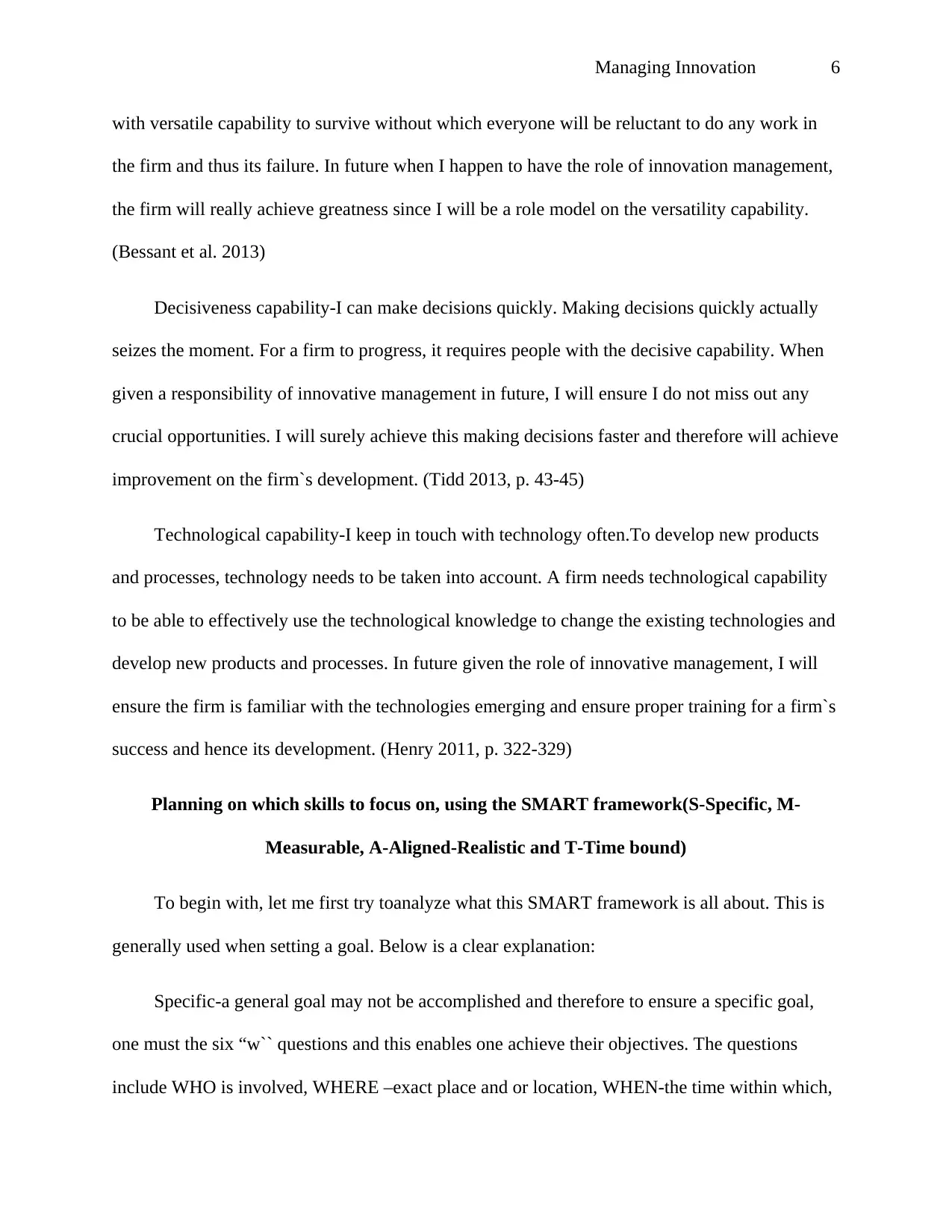
Managing Innovation 6
with versatile capability to survive without which everyone will be reluctant to do any work in
the firm and thus its failure. In future when I happen to have the role of innovation management,
the firm will really achieve greatness since I will be a role model on the versatility capability.
(Bessant et al. 2013)
Decisiveness capability-I can make decisions quickly. Making decisions quickly actually
seizes the moment. For a firm to progress, it requires people with the decisive capability. When
given a responsibility of innovative management in future, I will ensure I do not miss out any
crucial opportunities. I will surely achieve this making decisions faster and therefore will achieve
improvement on the firm`s development. (Tidd 2013, p. 43-45)
Technological capability-I keep in touch with technology often.To develop new products
and processes, technology needs to be taken into account. A firm needs technological capability
to be able to effectively use the technological knowledge to change the existing technologies and
develop new products and processes. In future given the role of innovative management, I will
ensure the firm is familiar with the technologies emerging and ensure proper training for a firm`s
success and hence its development. (Henry 2011, p. 322-329)
Planning on which skills to focus on, using the SMART framework(S-Specific, M-
Measurable, A-Aligned-Realistic and T-Time bound)
To begin with, let me first try toanalyze what this SMART framework is all about. This is
generally used when setting a goal. Below is a clear explanation:
Specific-a general goal may not be accomplished and therefore to ensure a specific goal,
one must the six “w`` questions and this enables one achieve their objectives. The questions
include WHO is involved, WHERE –exact place and or location, WHEN-the time within which,
with versatile capability to survive without which everyone will be reluctant to do any work in
the firm and thus its failure. In future when I happen to have the role of innovation management,
the firm will really achieve greatness since I will be a role model on the versatility capability.
(Bessant et al. 2013)
Decisiveness capability-I can make decisions quickly. Making decisions quickly actually
seizes the moment. For a firm to progress, it requires people with the decisive capability. When
given a responsibility of innovative management in future, I will ensure I do not miss out any
crucial opportunities. I will surely achieve this making decisions faster and therefore will achieve
improvement on the firm`s development. (Tidd 2013, p. 43-45)
Technological capability-I keep in touch with technology often.To develop new products
and processes, technology needs to be taken into account. A firm needs technological capability
to be able to effectively use the technological knowledge to change the existing technologies and
develop new products and processes. In future given the role of innovative management, I will
ensure the firm is familiar with the technologies emerging and ensure proper training for a firm`s
success and hence its development. (Henry 2011, p. 322-329)
Planning on which skills to focus on, using the SMART framework(S-Specific, M-
Measurable, A-Aligned-Realistic and T-Time bound)
To begin with, let me first try toanalyze what this SMART framework is all about. This is
generally used when setting a goal. Below is a clear explanation:
Specific-a general goal may not be accomplished and therefore to ensure a specific goal,
one must the six “w`` questions and this enables one achieve their objectives. The questions
include WHO is involved, WHERE –exact place and or location, WHEN-the time within which,
⊘ This is a preview!⊘
Do you want full access?
Subscribe today to unlock all pages.

Trusted by 1+ million students worldwide
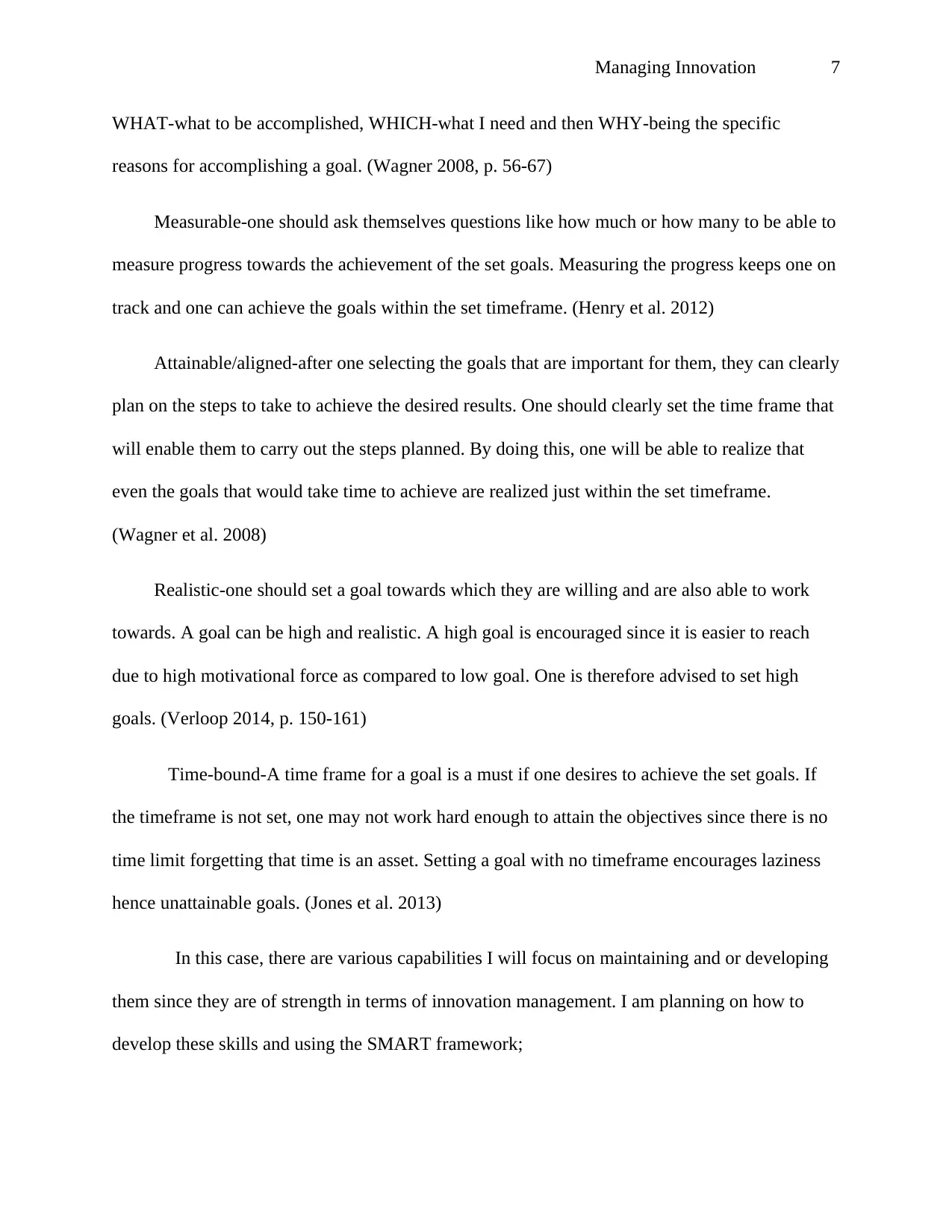
Managing Innovation 7
WHAT-what to be accomplished, WHICH-what I need and then WHY-being the specific
reasons for accomplishing a goal. (Wagner 2008, p. 56-67)
Measurable-one should ask themselves questions like how much or how many to be able to
measure progress towards the achievement of the set goals. Measuring the progress keeps one on
track and one can achieve the goals within the set timeframe. (Henry et al. 2012)
Attainable/aligned-after one selecting the goals that are important for them, they can clearly
plan on the steps to take to achieve the desired results. One should clearly set the time frame that
will enable them to carry out the steps planned. By doing this, one will be able to realize that
even the goals that would take time to achieve are realized just within the set timeframe.
(Wagner et al. 2008)
Realistic-one should set a goal towards which they are willing and are also able to work
towards. A goal can be high and realistic. A high goal is encouraged since it is easier to reach
due to high motivational force as compared to low goal. One is therefore advised to set high
goals. (Verloop 2014, p. 150-161)
Time-bound-A time frame for a goal is a must if one desires to achieve the set goals. If
the timeframe is not set, one may not work hard enough to attain the objectives since there is no
time limit forgetting that time is an asset. Setting a goal with no timeframe encourages laziness
hence unattainable goals. (Jones et al. 2013)
In this case, there are various capabilities I will focus on maintaining and or developing
them since they are of strength in terms of innovation management. I am planning on how to
develop these skills and using the SMART framework;
WHAT-what to be accomplished, WHICH-what I need and then WHY-being the specific
reasons for accomplishing a goal. (Wagner 2008, p. 56-67)
Measurable-one should ask themselves questions like how much or how many to be able to
measure progress towards the achievement of the set goals. Measuring the progress keeps one on
track and one can achieve the goals within the set timeframe. (Henry et al. 2012)
Attainable/aligned-after one selecting the goals that are important for them, they can clearly
plan on the steps to take to achieve the desired results. One should clearly set the time frame that
will enable them to carry out the steps planned. By doing this, one will be able to realize that
even the goals that would take time to achieve are realized just within the set timeframe.
(Wagner et al. 2008)
Realistic-one should set a goal towards which they are willing and are also able to work
towards. A goal can be high and realistic. A high goal is encouraged since it is easier to reach
due to high motivational force as compared to low goal. One is therefore advised to set high
goals. (Verloop 2014, p. 150-161)
Time-bound-A time frame for a goal is a must if one desires to achieve the set goals. If
the timeframe is not set, one may not work hard enough to attain the objectives since there is no
time limit forgetting that time is an asset. Setting a goal with no timeframe encourages laziness
hence unattainable goals. (Jones et al. 2013)
In this case, there are various capabilities I will focus on maintaining and or developing
them since they are of strength in terms of innovation management. I am planning on how to
develop these skills and using the SMART framework;
Paraphrase This Document
Need a fresh take? Get an instant paraphrase of this document with our AI Paraphraser
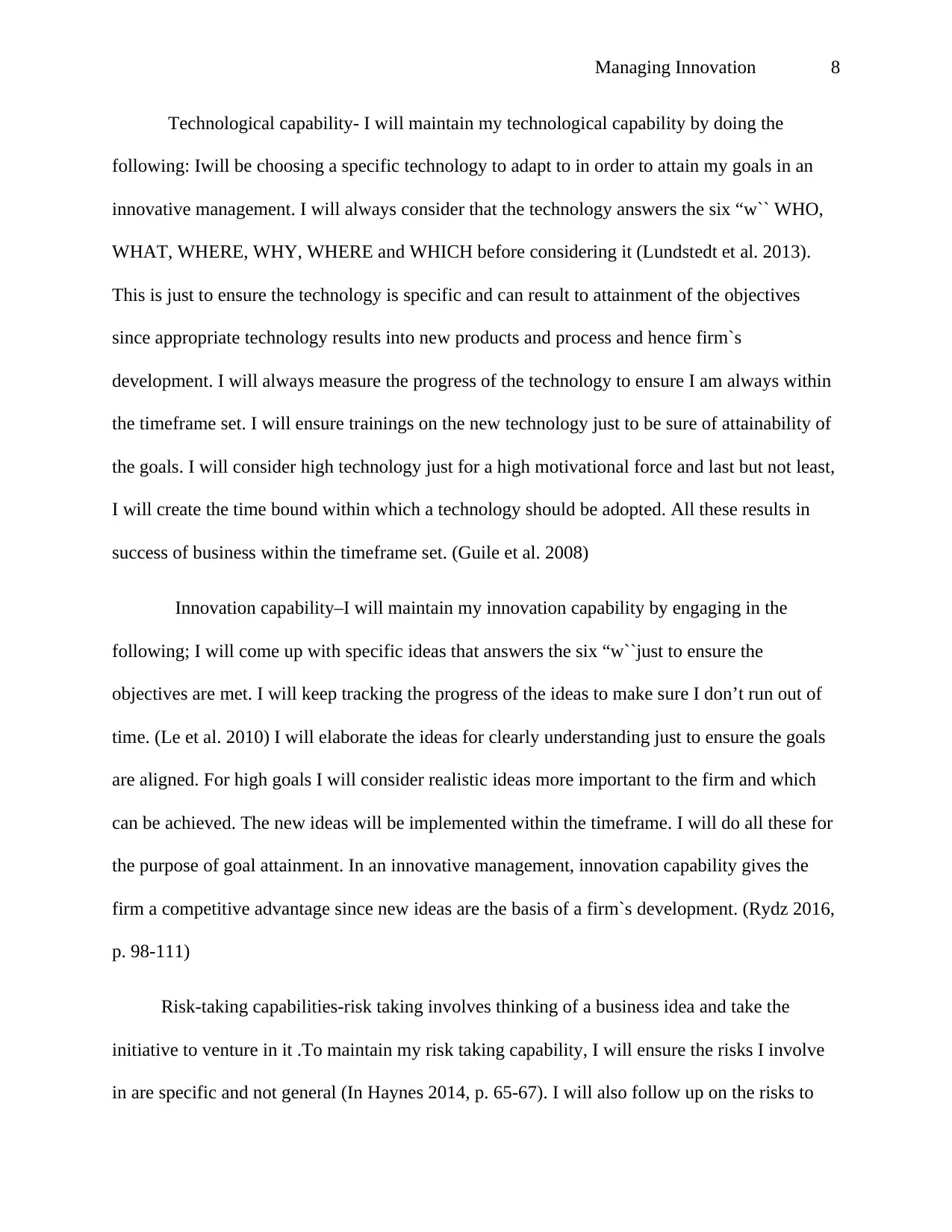
Managing Innovation 8
Technological capability- I will maintain my technological capability by doing the
following: Iwill be choosing a specific technology to adapt to in order to attain my goals in an
innovative management. I will always consider that the technology answers the six “w`` WHO,
WHAT, WHERE, WHY, WHERE and WHICH before considering it (Lundstedt et al. 2013).
This is just to ensure the technology is specific and can result to attainment of the objectives
since appropriate technology results into new products and process and hence firm`s
development. I will always measure the progress of the technology to ensure I am always within
the timeframe set. I will ensure trainings on the new technology just to be sure of attainability of
the goals. I will consider high technology just for a high motivational force and last but not least,
I will create the time bound within which a technology should be adopted. All these results in
success of business within the timeframe set. (Guile et al. 2008)
Innovation capability–I will maintain my innovation capability by engaging in the
following; I will come up with specific ideas that answers the six “w``just to ensure the
objectives are met. I will keep tracking the progress of the ideas to make sure I don’t run out of
time. (Le et al. 2010) I will elaborate the ideas for clearly understanding just to ensure the goals
are aligned. For high goals I will consider realistic ideas more important to the firm and which
can be achieved. The new ideas will be implemented within the timeframe. I will do all these for
the purpose of goal attainment. In an innovative management, innovation capability gives the
firm a competitive advantage since new ideas are the basis of a firm`s development. (Rydz 2016,
p. 98-111)
Risk-taking capabilities-risk taking involves thinking of a business idea and take the
initiative to venture in it .To maintain my risk taking capability, I will ensure the risks I involve
in are specific and not general (In Haynes 2014, p. 65-67). I will also follow up on the risks to
Technological capability- I will maintain my technological capability by doing the
following: Iwill be choosing a specific technology to adapt to in order to attain my goals in an
innovative management. I will always consider that the technology answers the six “w`` WHO,
WHAT, WHERE, WHY, WHERE and WHICH before considering it (Lundstedt et al. 2013).
This is just to ensure the technology is specific and can result to attainment of the objectives
since appropriate technology results into new products and process and hence firm`s
development. I will always measure the progress of the technology to ensure I am always within
the timeframe set. I will ensure trainings on the new technology just to be sure of attainability of
the goals. I will consider high technology just for a high motivational force and last but not least,
I will create the time bound within which a technology should be adopted. All these results in
success of business within the timeframe set. (Guile et al. 2008)
Innovation capability–I will maintain my innovation capability by engaging in the
following; I will come up with specific ideas that answers the six “w``just to ensure the
objectives are met. I will keep tracking the progress of the ideas to make sure I don’t run out of
time. (Le et al. 2010) I will elaborate the ideas for clearly understanding just to ensure the goals
are aligned. For high goals I will consider realistic ideas more important to the firm and which
can be achieved. The new ideas will be implemented within the timeframe. I will do all these for
the purpose of goal attainment. In an innovative management, innovation capability gives the
firm a competitive advantage since new ideas are the basis of a firm`s development. (Rydz 2016,
p. 98-111)
Risk-taking capabilities-risk taking involves thinking of a business idea and take the
initiative to venture in it .To maintain my risk taking capability, I will ensure the risks I involve
in are specific and not general (In Haynes 2014, p. 65-67). I will also follow up on the risks to
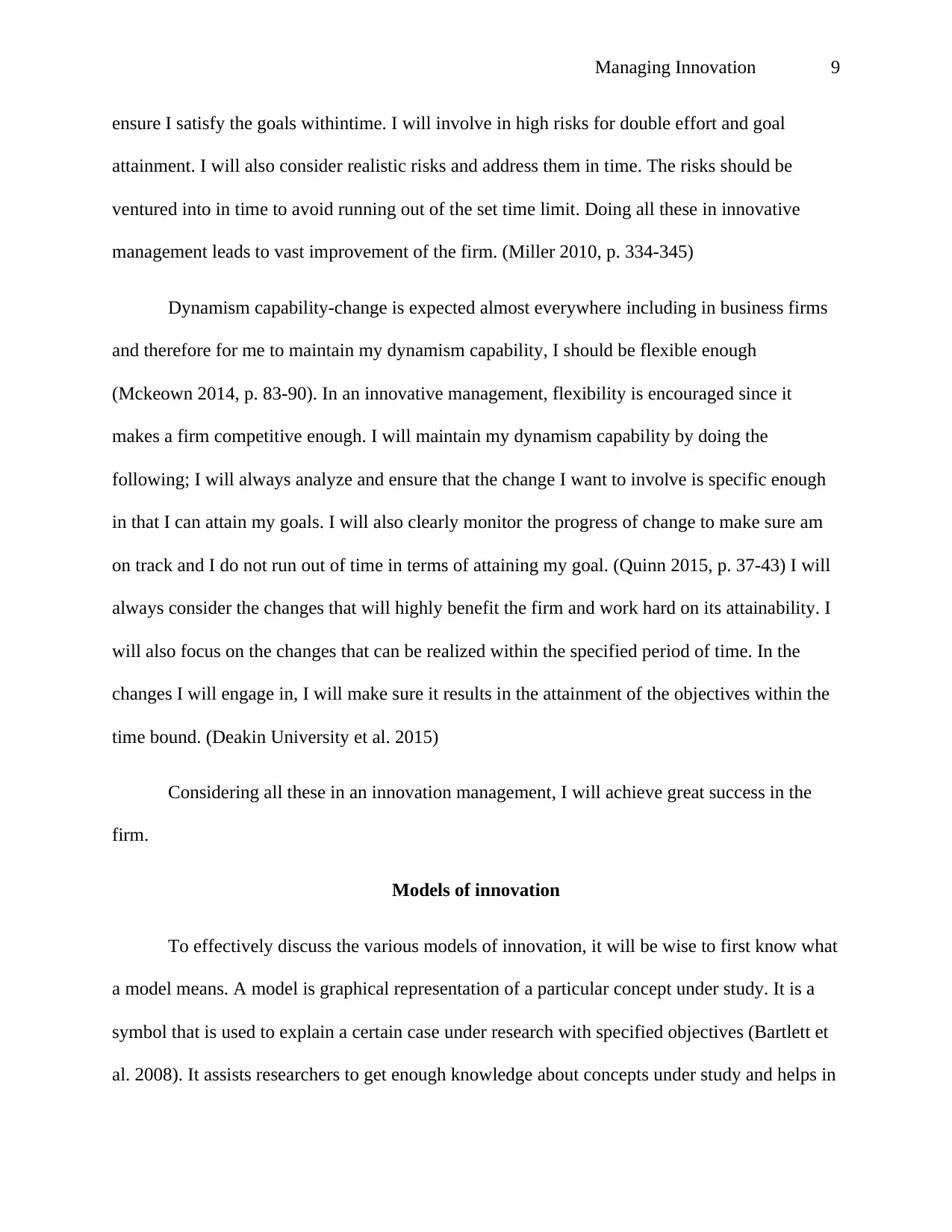
Managing Innovation 9
ensure I satisfy the goals withintime. I will involve in high risks for double effort and goal
attainment. I will also consider realistic risks and address them in time. The risks should be
ventured into in time to avoid running out of the set time limit. Doing all these in innovative
management leads to vast improvement of the firm. (Miller 2010, p. 334-345)
Dynamism capability-change is expected almost everywhere including in business firms
and therefore for me to maintain my dynamism capability, I should be flexible enough
(Mckeown 2014, p. 83-90). In an innovative management, flexibility is encouraged since it
makes a firm competitive enough. I will maintain my dynamism capability by doing the
following; I will always analyze and ensure that the change I want to involve is specific enough
in that I can attain my goals. I will also clearly monitor the progress of change to make sure am
on track and I do not run out of time in terms of attaining my goal. (Quinn 2015, p. 37-43) I will
always consider the changes that will highly benefit the firm and work hard on its attainability. I
will also focus on the changes that can be realized within the specified period of time. In the
changes I will engage in, I will make sure it results in the attainment of the objectives within the
time bound. (Deakin University et al. 2015)
Considering all these in an innovation management, I will achieve great success in the
firm.
Models of innovation
To effectively discuss the various models of innovation, it will be wise to first know what
a model means. A model is graphical representation of a particular concept under study. It is a
symbol that is used to explain a certain case under research with specified objectives (Bartlett et
al. 2008). It assists researchers to get enough knowledge about concepts under study and helps in
ensure I satisfy the goals withintime. I will involve in high risks for double effort and goal
attainment. I will also consider realistic risks and address them in time. The risks should be
ventured into in time to avoid running out of the set time limit. Doing all these in innovative
management leads to vast improvement of the firm. (Miller 2010, p. 334-345)
Dynamism capability-change is expected almost everywhere including in business firms
and therefore for me to maintain my dynamism capability, I should be flexible enough
(Mckeown 2014, p. 83-90). In an innovative management, flexibility is encouraged since it
makes a firm competitive enough. I will maintain my dynamism capability by doing the
following; I will always analyze and ensure that the change I want to involve is specific enough
in that I can attain my goals. I will also clearly monitor the progress of change to make sure am
on track and I do not run out of time in terms of attaining my goal. (Quinn 2015, p. 37-43) I will
always consider the changes that will highly benefit the firm and work hard on its attainability. I
will also focus on the changes that can be realized within the specified period of time. In the
changes I will engage in, I will make sure it results in the attainment of the objectives within the
time bound. (Deakin University et al. 2015)
Considering all these in an innovation management, I will achieve great success in the
firm.
Models of innovation
To effectively discuss the various models of innovation, it will be wise to first know what
a model means. A model is graphical representation of a particular concept under study. It is a
symbol that is used to explain a certain case under research with specified objectives (Bartlett et
al. 2008). It assists researchers to get enough knowledge about concepts under study and helps in
⊘ This is a preview!⊘
Do you want full access?
Subscribe today to unlock all pages.

Trusted by 1+ million students worldwide
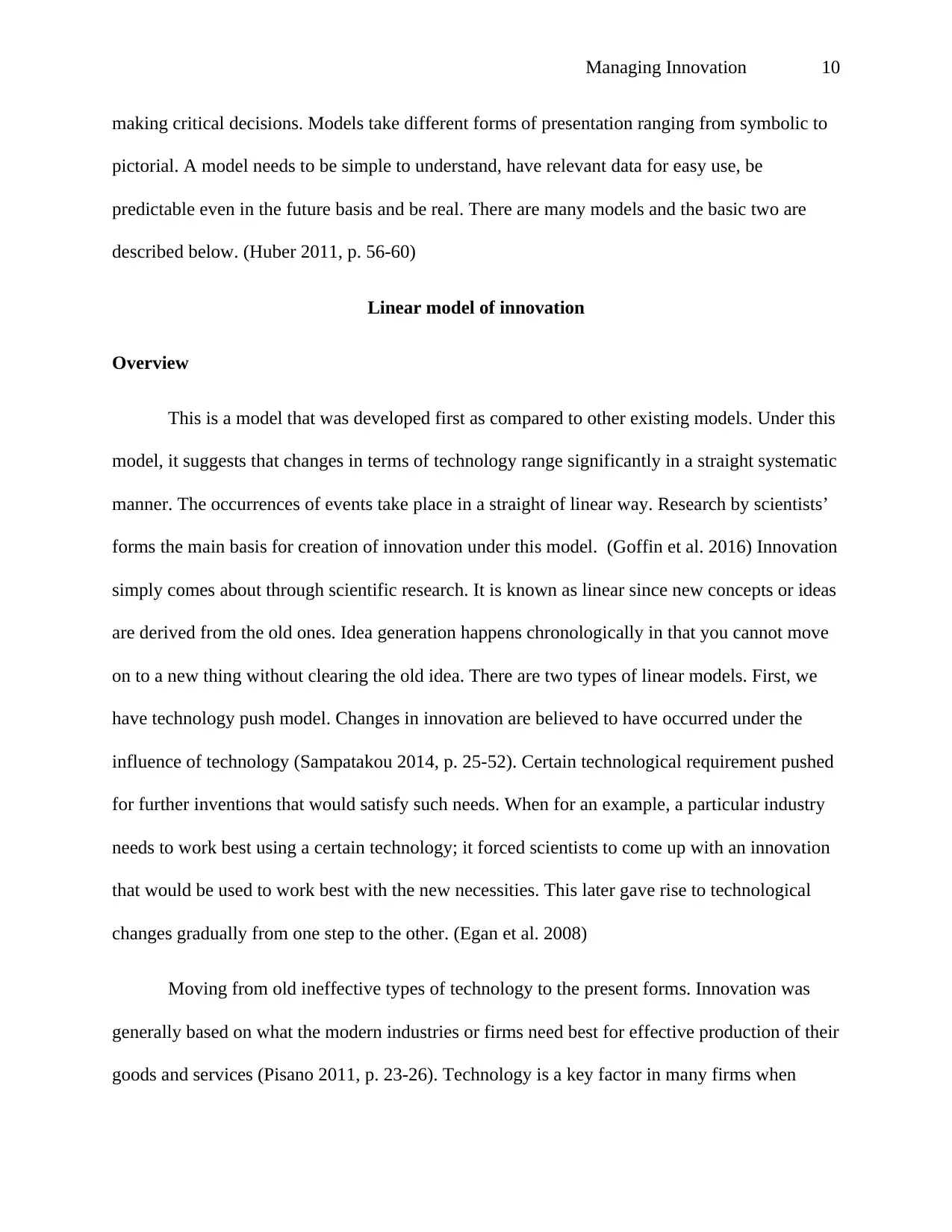
Managing Innovation 10
making critical decisions. Models take different forms of presentation ranging from symbolic to
pictorial. A model needs to be simple to understand, have relevant data for easy use, be
predictable even in the future basis and be real. There are many models and the basic two are
described below. (Huber 2011, p. 56-60)
Linear model of innovation
Overview
This is a model that was developed first as compared to other existing models. Under this
model, it suggests that changes in terms of technology range significantly in a straight systematic
manner. The occurrences of events take place in a straight of linear way. Research by scientists’
forms the main basis for creation of innovation under this model. (Goffin et al. 2016) Innovation
simply comes about through scientific research. It is known as linear since new concepts or ideas
are derived from the old ones. Idea generation happens chronologically in that you cannot move
on to a new thing without clearing the old idea. There are two types of linear models. First, we
have technology push model. Changes in innovation are believed to have occurred under the
influence of technology (Sampatakou 2014, p. 25-52). Certain technological requirement pushed
for further inventions that would satisfy such needs. When for an example, a particular industry
needs to work best using a certain technology; it forced scientists to come up with an innovation
that would be used to work best with the new necessities. This later gave rise to technological
changes gradually from one step to the other. (Egan et al. 2008)
Moving from old ineffective types of technology to the present forms. Innovation was
generally based on what the modern industries or firms need best for effective production of their
goods and services (Pisano 2011, p. 23-26). Technology is a key factor in many firms when
making critical decisions. Models take different forms of presentation ranging from symbolic to
pictorial. A model needs to be simple to understand, have relevant data for easy use, be
predictable even in the future basis and be real. There are many models and the basic two are
described below. (Huber 2011, p. 56-60)
Linear model of innovation
Overview
This is a model that was developed first as compared to other existing models. Under this
model, it suggests that changes in terms of technology range significantly in a straight systematic
manner. The occurrences of events take place in a straight of linear way. Research by scientists’
forms the main basis for creation of innovation under this model. (Goffin et al. 2016) Innovation
simply comes about through scientific research. It is known as linear since new concepts or ideas
are derived from the old ones. Idea generation happens chronologically in that you cannot move
on to a new thing without clearing the old idea. There are two types of linear models. First, we
have technology push model. Changes in innovation are believed to have occurred under the
influence of technology (Sampatakou 2014, p. 25-52). Certain technological requirement pushed
for further inventions that would satisfy such needs. When for an example, a particular industry
needs to work best using a certain technology; it forced scientists to come up with an innovation
that would be used to work best with the new necessities. This later gave rise to technological
changes gradually from one step to the other. (Egan et al. 2008)
Moving from old ineffective types of technology to the present forms. Innovation was
generally based on what the modern industries or firms need best for effective production of their
goods and services (Pisano 2011, p. 23-26). Technology is a key factor in many firms when
Paraphrase This Document
Need a fresh take? Get an instant paraphrase of this document with our AI Paraphraser
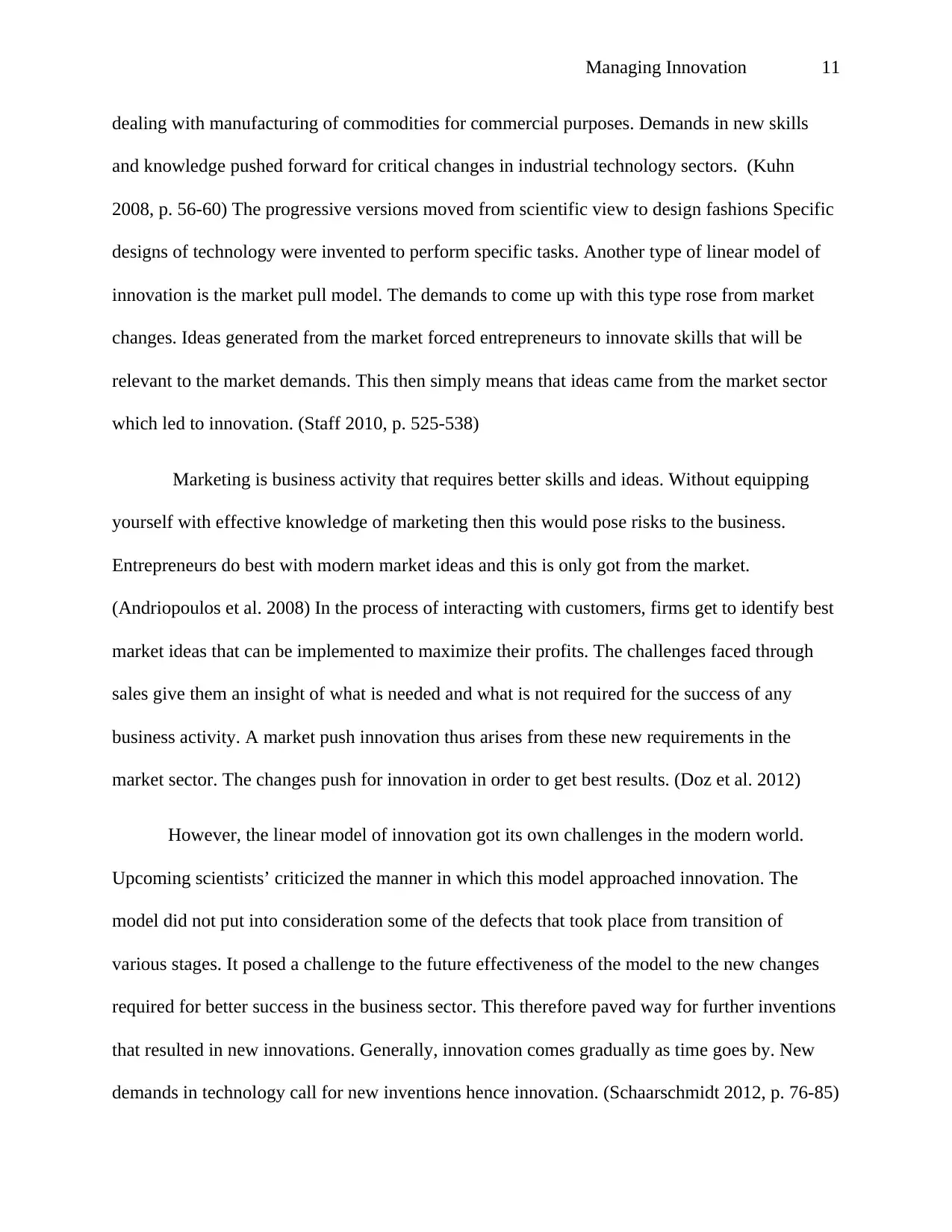
Managing Innovation 11
dealing with manufacturing of commodities for commercial purposes. Demands in new skills
and knowledge pushed forward for critical changes in industrial technology sectors. (Kuhn
2008, p. 56-60) The progressive versions moved from scientific view to design fashions Specific
designs of technology were invented to perform specific tasks. Another type of linear model of
innovation is the market pull model. The demands to come up with this type rose from market
changes. Ideas generated from the market forced entrepreneurs to innovate skills that will be
relevant to the market demands. This then simply means that ideas came from the market sector
which led to innovation. (Staff 2010, p. 525-538)
Marketing is business activity that requires better skills and ideas. Without equipping
yourself with effective knowledge of marketing then this would pose risks to the business.
Entrepreneurs do best with modern market ideas and this is only got from the market.
(Andriopoulos et al. 2008) In the process of interacting with customers, firms get to identify best
market ideas that can be implemented to maximize their profits. The challenges faced through
sales give them an insight of what is needed and what is not required for the success of any
business activity. A market push innovation thus arises from these new requirements in the
market sector. The changes push for innovation in order to get best results. (Doz et al. 2012)
However, the linear model of innovation got its own challenges in the modern world.
Upcoming scientists’ criticized the manner in which this model approached innovation. The
model did not put into consideration some of the defects that took place from transition of
various stages. It posed a challenge to the future effectiveness of the model to the new changes
required for better success in the business sector. This therefore paved way for further inventions
that resulted in new innovations. Generally, innovation comes gradually as time goes by. New
demands in technology call for new inventions hence innovation. (Schaarschmidt 2012, p. 76-85)
dealing with manufacturing of commodities for commercial purposes. Demands in new skills
and knowledge pushed forward for critical changes in industrial technology sectors. (Kuhn
2008, p. 56-60) The progressive versions moved from scientific view to design fashions Specific
designs of technology were invented to perform specific tasks. Another type of linear model of
innovation is the market pull model. The demands to come up with this type rose from market
changes. Ideas generated from the market forced entrepreneurs to innovate skills that will be
relevant to the market demands. This then simply means that ideas came from the market sector
which led to innovation. (Staff 2010, p. 525-538)
Marketing is business activity that requires better skills and ideas. Without equipping
yourself with effective knowledge of marketing then this would pose risks to the business.
Entrepreneurs do best with modern market ideas and this is only got from the market.
(Andriopoulos et al. 2008) In the process of interacting with customers, firms get to identify best
market ideas that can be implemented to maximize their profits. The challenges faced through
sales give them an insight of what is needed and what is not required for the success of any
business activity. A market push innovation thus arises from these new requirements in the
market sector. The changes push for innovation in order to get best results. (Doz et al. 2012)
However, the linear model of innovation got its own challenges in the modern world.
Upcoming scientists’ criticized the manner in which this model approached innovation. The
model did not put into consideration some of the defects that took place from transition of
various stages. It posed a challenge to the future effectiveness of the model to the new changes
required for better success in the business sector. This therefore paved way for further inventions
that resulted in new innovations. Generally, innovation comes gradually as time goes by. New
demands in technology call for new inventions hence innovation. (Schaarschmidt 2012, p. 76-85)
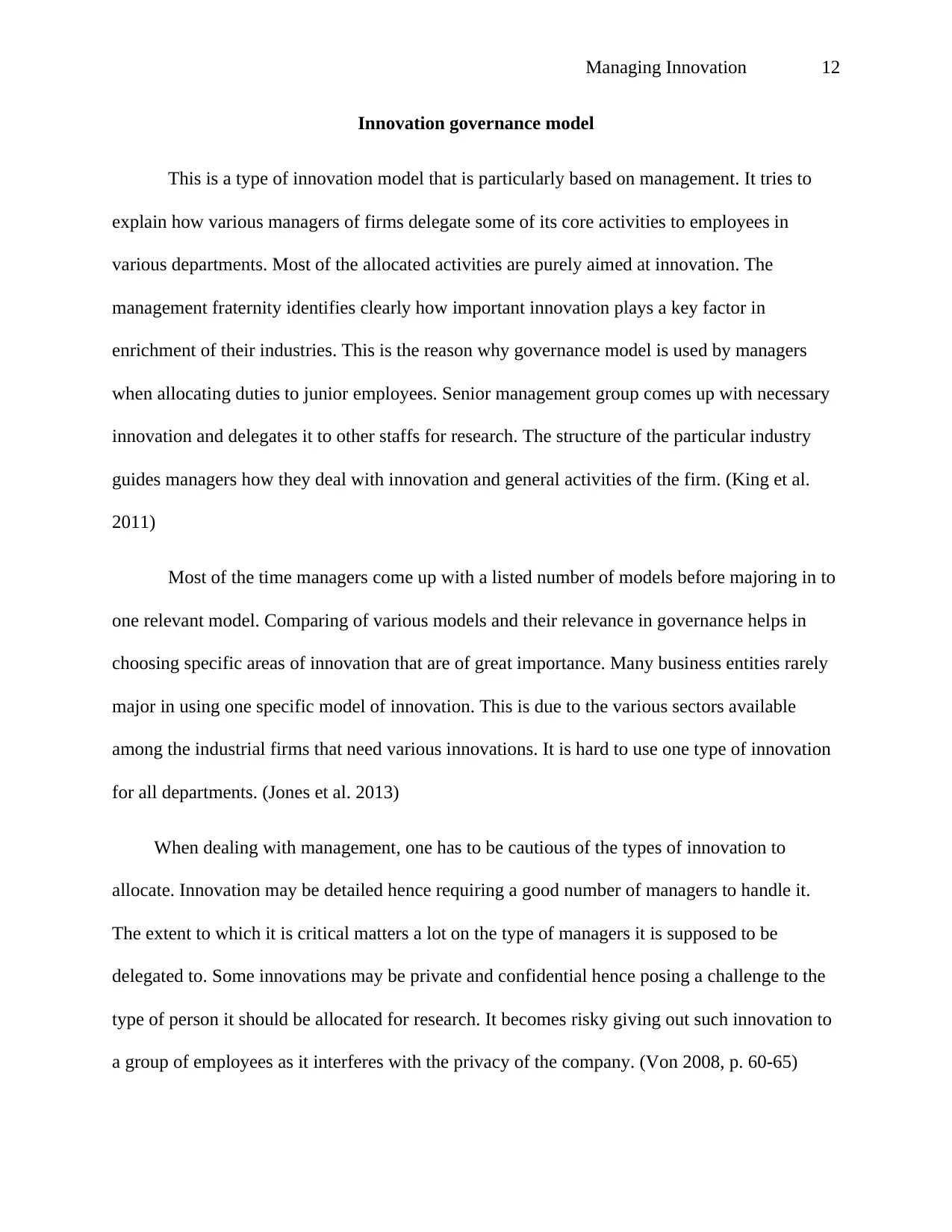
Managing Innovation 12
Innovation governance model
This is a type of innovation model that is particularly based on management. It tries to
explain how various managers of firms delegate some of its core activities to employees in
various departments. Most of the allocated activities are purely aimed at innovation. The
management fraternity identifies clearly how important innovation plays a key factor in
enrichment of their industries. This is the reason why governance model is used by managers
when allocating duties to junior employees. Senior management group comes up with necessary
innovation and delegates it to other staffs for research. The structure of the particular industry
guides managers how they deal with innovation and general activities of the firm. (King et al.
2011)
Most of the time managers come up with a listed number of models before majoring in to
one relevant model. Comparing of various models and their relevance in governance helps in
choosing specific areas of innovation that are of great importance. Many business entities rarely
major in using one specific model of innovation. This is due to the various sectors available
among the industrial firms that need various innovations. It is hard to use one type of innovation
for all departments. (Jones et al. 2013)
When dealing with management, one has to be cautious of the types of innovation to
allocate. Innovation may be detailed hence requiring a good number of managers to handle it.
The extent to which it is critical matters a lot on the type of managers it is supposed to be
delegated to. Some innovations may be private and confidential hence posing a challenge to the
type of person it should be allocated for research. It becomes risky giving out such innovation to
a group of employees as it interferes with the privacy of the company. (Von 2008, p. 60-65)
Innovation governance model
This is a type of innovation model that is particularly based on management. It tries to
explain how various managers of firms delegate some of its core activities to employees in
various departments. Most of the allocated activities are purely aimed at innovation. The
management fraternity identifies clearly how important innovation plays a key factor in
enrichment of their industries. This is the reason why governance model is used by managers
when allocating duties to junior employees. Senior management group comes up with necessary
innovation and delegates it to other staffs for research. The structure of the particular industry
guides managers how they deal with innovation and general activities of the firm. (King et al.
2011)
Most of the time managers come up with a listed number of models before majoring in to
one relevant model. Comparing of various models and their relevance in governance helps in
choosing specific areas of innovation that are of great importance. Many business entities rarely
major in using one specific model of innovation. This is due to the various sectors available
among the industrial firms that need various innovations. It is hard to use one type of innovation
for all departments. (Jones et al. 2013)
When dealing with management, one has to be cautious of the types of innovation to
allocate. Innovation may be detailed hence requiring a good number of managers to handle it.
The extent to which it is critical matters a lot on the type of managers it is supposed to be
delegated to. Some innovations may be private and confidential hence posing a challenge to the
type of person it should be allocated for research. It becomes risky giving out such innovation to
a group of employees as it interferes with the privacy of the company. (Von 2008, p. 60-65)
⊘ This is a preview!⊘
Do you want full access?
Subscribe today to unlock all pages.

Trusted by 1+ million students worldwide
1 out of 19
Related Documents
Your All-in-One AI-Powered Toolkit for Academic Success.
+13062052269
info@desklib.com
Available 24*7 on WhatsApp / Email
![[object Object]](/_next/static/media/star-bottom.7253800d.svg)
Unlock your academic potential
Copyright © 2020–2025 A2Z Services. All Rights Reserved. Developed and managed by ZUCOL.




